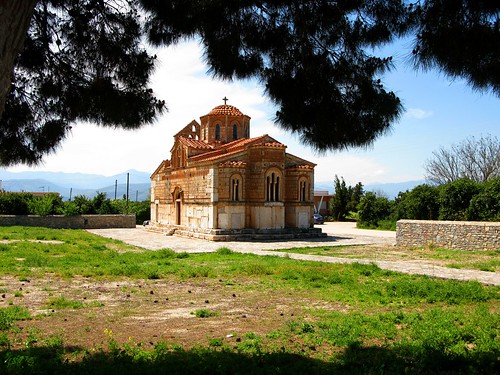
The church just outside the modern village of Aghia Triada is dedicated to the dormition of the theotokos. It was built some time in the period between about a century before and after the fourth crusade. The actual dating is one of the great mysteries of the building as it rests to some extent on written evidence (which may or may not be flawed) for the building of a nearby stylistically similar church and to some extent on the immured ceramics. Τhe dating of these are also much debated by scholars, not least because the dating of the immured ceramics had been 'fixed' by a possibly inaccurate date for this church itself.
The village of Aghia Triada used to be known as Merbakas. The old name is largely forgotten outside Byzantist circles apart from its pejorative use in the phrase: "Καλά ρε φίλε, απ΄τον Μέρμπακα είσαι;" as used even into the 1990s by Nafplio kids to indicate a school friend is particularly stupid.
I first heard of the village in 1988 when touring the Peloponnese with JHWM (and PAGS) although there was no time to visit the church, and again in 1990 when SFM replaced PAGS. I don't think I actually saw the church itself until 1995 or even as late as 1998, when it was still serving as the cemetery church and the village cemetery itself still surrounded the church.
I have tried to drive past the church every time I have visited the area since then. Every time I visit, I see more and every time I leave I read more about it and around it and come back with more to look at. There is so much to look at in this one small Byzantine building and while something is urging me to insert the word intertextuality in here somewhere, I fear that so many years away from mildewey libraries may have blunted my ability to pull off that sort of writing...
Merbakas is unknown as a toponym elsewhere in the Balkans or even in Turkey. The word is not encountered in any of the languages of the peoples who have at some time established themselves in the Peloponnese. However, the Dutch village of Moerbeke happens to be the place of origin of William of Moerbeke, Latin bishop of Corinth, a Dominican and a pretty shit-hot classical scholar of his time. So while many chose to deny any link with Moerbeke for whatever reasons, if we do so, another William (almost contemporary with ours, but Franciscan and an Englishman from Ockham in Surrey) would have been rightly upset.
I cannot write about the similarities and differences with the churches at Areia and Chonikas, nor do I know enough about the ceramics to make some sort of judgment on the date of the church and therefore the likelihood of the patron being William of Moerbeke. Guy Sanders has a paper up on academia.edu in which he argues for the late date and the patronage of William. Although every time I read the paper I end up on different sides of the fence as to whether he convinces, the questions being asked are definitely going in the right direction.
The late date is supported by the ceramic evidence. The church has a whole lot of ceramic bowls immured in the walls. The mortar used has been shown to be one with the mortar used in the building of the walls: hence the bowls are contemporary with the original building, and dating the bowls will allow dating the church.
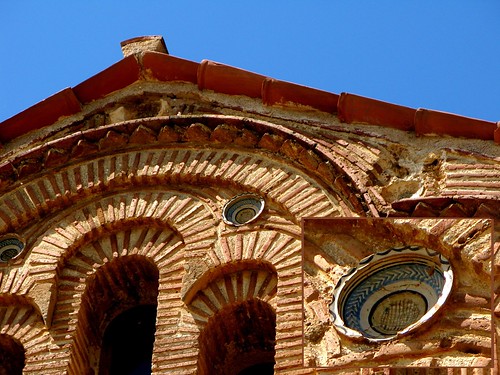
The bowls in this images are called Grid Iron Protomaiolica bowls. Similar bowls are immured in the walls of the Dormition at Gastouni which has been recently dated to the last quarter of the 13th Century. The bowls are the product of a Western (Italian) workshop. Other immured ceramics have an eastern provenance, such as the Zeuxippus ware from Constantinople. The choice of ceramics from both edges of the Greek world, east and west is used by Sanders to support his position.
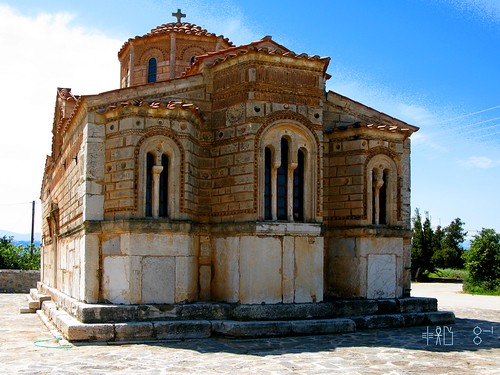
This view from the apses gives an opportunity to see a number of features of the church. From the ground up, we have the three steps reminiscent of an ancient stylobate. Christianity standing on ancient foundations, or triumphing over the old religion? The lower courses actually use building blocks taken from the Argive Heraion a few kilometers distant, while the blocks in the higher courses were brought from Corinth, presumably quarried fresh from local stone.
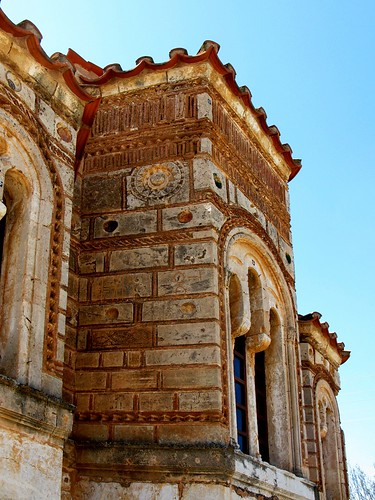
The higher courses are in cloisonné style with decorative brick-work at the top made to look like a Greek key (meander).

The central apse, with its Gothic engaged columns in the trilobed sanctuary window, and more Greek key decorative brickwork. A meander is also visible running horizontally in the marble under the windows.
So, going back to the spolia... apart from the otherwise non-descript blocks from the Argive Heraion (which I still have yet to visit), there are two blocks of spolia with figured representations still on the church (a third is in Copenhagen, for some reason), in addition to a classical sundial reincorporated into the wall of the church and two blocks bearing inscriptions.

The sundial is on the south wall towards the SW corner.

One of the two, figured spolia. The low relief sculpture is a classical grave marker with three figures on it. There is an inscription which reads something along the lines of "[Ε]ΥΠΟΡΟΣ ΕΥΠΡΑΞΙΣ [Ζ]ΗΑΝΤΕΡΩ[Σ]" which is probably three proper names. The Inscriptiones Graecae online gives the text as: Εὔπορος Ἀντέρωτος. Εὔπραξις ζῇ. Ἀντέρως and if I had not looked it up in the concordance, I would not have noticed the lower line of text underneath the text Εὔπορος. Have I mentioned how much I love the internet? The inscription is known as IG IV 539. Given the probably correct reading in the IG catalogue, it is probably a marker for Euporos (on the left) who was the son of Anteros on the right and is survived by his mother Eupraxis (centre).
It is said that the village ultimately gets its modern name from this grave marker, by way of the village church, which was dedicated to the holy trinity because of this very prominent spolion on the corner of the village's cemetery church.
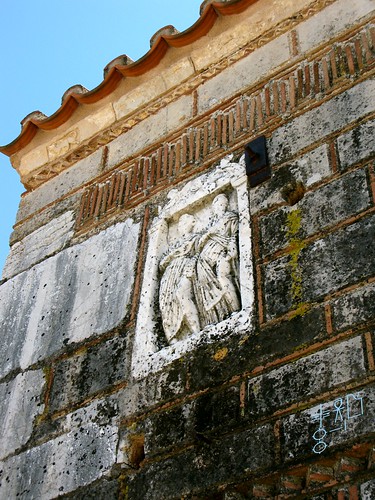
The second stele on the north wall of the church, shows two more classical figures, with no discernable inscription. The placing of the two grave stelai and the subject matter are used to argue for the involvement of a Latin churchman in the foundation and building of the church at a time when the argument over the filioque was ongoing. The north stele shows two figures (argued to represent the father and the son from whom the unseen spirit is presumably processing in a western way) and the south stele shows the holy trinity in all its orthodox oriental glory. I don't buy into this in a wholehearted way, although as circumstantial evidence, I feel it ought to be mentioned.
Next up, the two spolia with inscriptions, one placed near the north door, the other near the east door. The one near the east door I did not know about and as a result, I have not got a photograph of it (and it is not immediately obvious when looking for it, else I would have noticed).

This is the first inscription, reading: Q(UINTO) CAECILIO C(AII) F(ILIO) METELO | IMPERATORI ITALICI | QVEI ARGEIS NEGOTIA(NTUR). Now the Metelus in question was the chappy who conquered Crete for Rome, thereby clearing the Aegean and this part of the Mediterranean of piracy. To me the echoes with the council of Lyons which amongst other things (such as the union of the churches) sought to suppress piracy are a little faint, but it has been argued that the founder of the church was aware of the historical Metellus and wished to make such a link. In any case, it is strange that a text in latin script which would not have been understood at all by the local population was immured with the inscription visible.
The final spolion bears a Greek dedicatory inscription and is immured close to the east door. As I have already mentioned, I have not seen it.
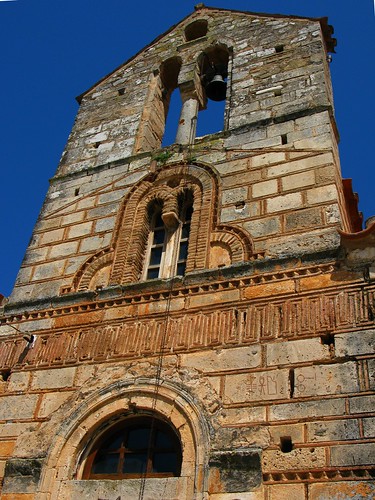
The bell tower above the east door, where the spolion bearing a Greek inscription is to be found.

The dome colonettes, showing gothic architectural influences. The crocket capitals are a decorative element common in Gothic architecture. This element is also used as an ornament on furniture and metalwork in the Gothic style. The name derives from the diminutive of the French croc, meaning "hook", due to the resemblance of crockets to a bishop's crosier.
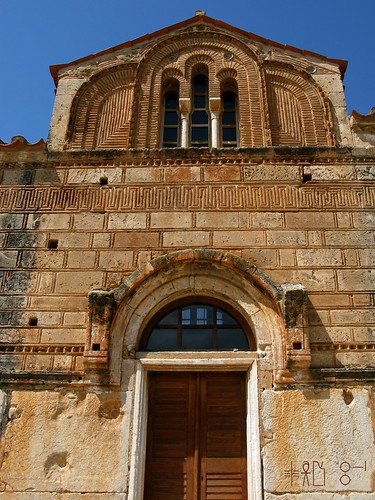
And final photo – the south door, which is built in the Byzantine rather than the western style (all other doors on the building are built in the western style). In Byzantine architecture, the jambs are separate from the matrix of the walls, as they are here. In western doors, the jambs bond with the walls.
Next time I have to go back, with all this in mind, to take photographs which illustrate the points in question better. As it is, the information on the church I got from the internet fit reasonably nicely with the photos I took, but not perfectly. Next time, it would be nice to get inside too to see the frescoes of St. Leo of Catania and to see how truly western some of the non-figured frescoes are.

1 comment:
Thanks so much for your fascinating description of this beautiful old church. I found it after looking further into a comment in a travel book on Greece (DK Eyewitness Travel. Greece, Athens & the Mainland, 181:2013).
I will be spending a week visiting the Peloponnese in May 2014 with my husband, and we are now very keen to visit this church in Agia Triada.
Once again, thank you for disseminating your knowledge to a broader, lay, audience.
Post a Comment